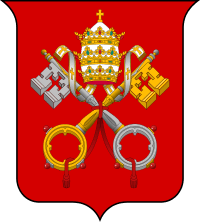Santo Stefano degli Ungheresi
Santo Stefano degli Ungheresi (also San Stefanino and Santo Stefano degli Unni) was the church of the Hungarians in Rome. Located next to the Vatican, the old church was pulled down in 1776, to make room for an extension of St. Peter's Basilica.
| Churches in the Vatican City in 1748 | |||||||||||||||||||
| |||||||||||||||||||
| Demolished churches | |||||||||||||||||||
|
Description
The church of Santo Stefano was established by Charlemagne in the 9th century. It was a basilical building with three naves. The eight granite columns supporting the roof were Roman spolia. The church was granted to King Stephen I in 1000 by Pope Sylvester II. The first Christian king of the Magyars received his crown from the Pope that year.
Stephen restored and enlarged the old building. He established a chapter house for twelve canons and a pilgrim's hostel for Hungarian travelers (predecessor of present-day Casa di Santo Stefano). The "Hungarian institutions", as they were called, played an important part in maintaining intensive diplomatic relations between medieval Hungary and the Holy See. They were also a place of learning for Hungarian clerics and intellectuals living in Rome.
Around the chapter house and the pilgrim's hostel, there were farm buildings like granaries, store-yards, and mills. The whole complex was surrounded by a wall.
The "Hungarian institutions" were sustained by the income of large estates in the vicinity of Rome. These estates, granted to Stephen I by the Pope, remained in the possession of the Kingdom of Hungary for hundreds of years. The last one in Celsano was only lost after World War II.
King Stephen I was canonized in 1083, and the church was dedicated to him under the name "Santo Stefano dei Ungheresi". It was restored by Sigismund of Luxemburg, King of Hungary, in the 15th century. Later, it was entrusted to the Pauline Fathers, the only monastical order founded by Hungarians.
In the 16th century, the nearby St. Peter's Basilica was rebuilt in Renaissance style and it was greatly enlarged. The Hungarian chapter house and the farm-buildings were pulled down to make way for the new basilica.
Demolition
In 1776, Pope Pius VI built a new sacristy for St. Peter's and expropriated the old church of Santo Stefano. The Pope gave 7500 scudi for the Collegium Germanicum et Hungaricum as compensation for the loss. Hungarians lost their national church in Rome, but unofficially Santo Stefano Rotondo on Caelian Hill took over this role, where Pius VI built a new chapel for St Stephen. Seven of the original Roman columns of the church were preserved in the new sacristy of St. Peter's.
See also
Further reading
- Hülsen, Christian (1927), Le chiese di Roma nel Medio Evo (in Italian), Firenze, pp. 477–478, retrieved 29 April 2011
- Jordan, Henri; Hülsen, Christian (1907), "Die Insel. Die Stadttheile am Rechten Tiberufer", Topographie der stadt Rom im alterthum (in German), Berlin: Weidmannsche Buchhandlung, pp. 622–669, retrieved 6 May 2011
- Rendina, Claudio (2007), Le chiese di Roma : storie, leggende e curiosità degli edifici sacri della Città Eterna, dai templi pagani alle grandi basiliche, dai conventi ai monasteri ai luoghi di culto in periferia (in Italian), Roma: Newton Compton, ISBN 978-88-541-0931-5
External links
| |||||||||||||||||||||||||||||||||||||
Coordinates: 41°54′3.83″N 12°27′12.43″E / 41.9010639°N 12.4534528°E
_01-12_cropped.jpg)

